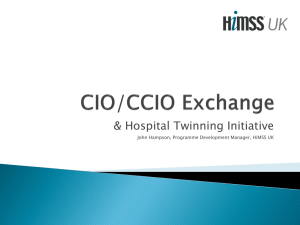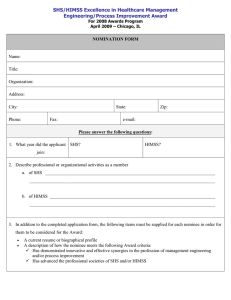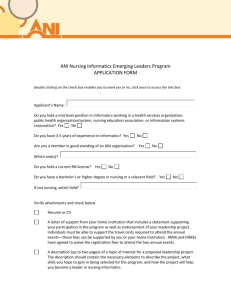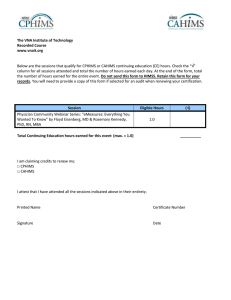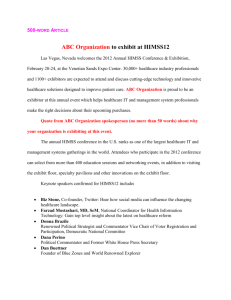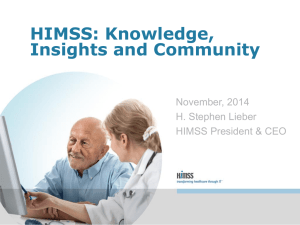Guiding Principles for Big Data in Nursing
advertisement
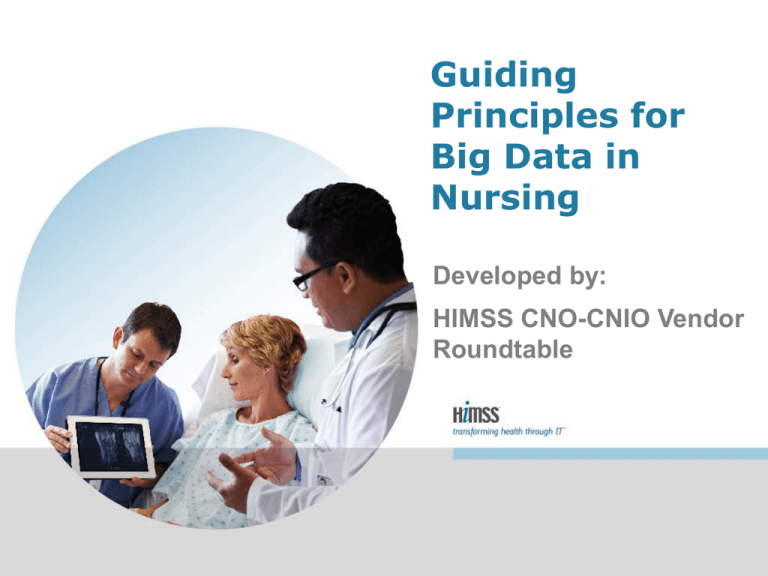
Guiding Principles for Big Data in Nursing Developed by: HIMSS CNO-CNIO Vendor Roundtable About HIMSS HIMSS is a global, cause-based, not-for-profit organization focused on better health through information technology (IT). Vision: Better health through information technology Mission: Globally, lead endeavors optimizing health engagements and care outcomes through information technology About the HIMSS CNO-CNIO Vendor Roundtable • Established in January 2014 • Includes HIMSS Diamond and Platinum member nurse executives • Co-facilitators – Gail Latimer, MSN, RN, FACHE, FAAN – Roy Simpson, DNP, RN, DPNAP, FAAN • 3 workgroups established • Staff liaisons – Maria Thornblad, Christel Anderson & Joyce Sensmeier HIMSS CNO-CNIO Vendor Roundtable Purpose & Objectives • To optimize health engagement and care outcomes through IT by leveraging the thought leadership of HIT vendor nurse executives – Serve as an advocate and leader for the nursing community – Provide guidance on informatics competencies for nursing – Provide guidance on EHR related topics including analytics, interoperability, usability, terminology, workflow, quality and outcomes Workgroup Structure • Vendor Nurse Role – Define the nurse vendor leadership role, identify competencies and value to the profession • Human Factors, Usability, Safety – Identify resources and opportunities to improve knowledge re: human factors, usability & safety • Big Data Principles – Develop big data principles/recommendations Big Data Principles Workgroup Member Title Organization Ellen Harper, DNP, RN-BC, MBA, FAAN co-chair Vice President, CNO - Premier West Cerner Joyce Sensmeier, MS, RN-BC, CPHIMS, FHIMSS, FAAN cochair Vice President, Informatics HIMSS Sue Lundquist, BSN, RN-BC Director, Patient Care Solutions, Health Services Cerner Marion McCall, BBA, RN, CNOR, CPHIMS Chief Clinical Officer OverSite Solutions Beth Meyers, RN, MS, CNOR Chief Nurse Executive, Analytics Strategy Director Infor Sara Parkerson, RN, MSN Clinical Solution Development Manager Philips Libby Rollinson, MSN, RN Director, Content Solutions, Enterprise Information Solutions McKesson Why Big Data? • Organizations are keen on gaining insights and instituting organizational change from the vast amounts of data being collected from their EHR systems. • Participants in the healthcare ecosystem are trying to reduce the cost and improve the quality of care by applying advanced analytics to both internally and externally generated data. • Technological advances enable larger volumes of structured and unstructured data to be managed and analyzed through faster, more efficient and cheaper computing (processors, storage, and advanced software) and through pervasive computing (telecomputing, mobile devices and sensors). HIMSS Data and Analytics Task Force July 2014 Big Data - Sharable & Comparable Harper, E. (2015). Clinical Integration and the Continuum of Care [PowerPoint slides]. Retrieved from http://files.himss.org/2015Conference/handouts/NI5_1428848643264_4.pdf Top 10 Recommendations Promote Standards and Interoperability 1) Nurses should promote the use of standardized and accepted terminologies that address the documentation needs of the entire care team regardless of care setting. All care delivery settings should create a plan for implementing an ANArecognized nursing terminology that is mapped to national standards i.e. SNOMED CT or LOINC Top 10 Recommendations Promote Standards and Interoperability 2) Nurses should recommend consistent use of research-based assessment scales and instruments that are standardized through an international consensus body. The lack of standardization makes comparison of data challenging and adds to the burden of cost for copyright permissions and/or licensing of such instruments Top 10 Recommendations Promote Standards and Interoperability 3) The ANA-recognized nursing terminologies should be consistently updated and made available to international standards organizations for translation and complete, comprehensive mapping Top 10 Recommendations Promote Standards and Interoperability 4) Minimize use of free text documentation. When ‘within defined limits’ is used, discrete data elements should be stored within the EHR to enable decision support, research, analytics and knowledge generation Cerner. (2015). Clinical Integration and the Continuum of Care [PowerPoint slides]. Retrieved from http://files.himss.org/2015Conference/handouts/NI5_1428848643264_4.pdf Top 10 Recommendations Advance Quality eMeasures 5) Efforts to develop and design quality eMeasures must ensure the data to be collected and measured are aligned with the clinician’s workflow, not as additional documentation Top 10 Recommendations Advance Quality eMeasures 6) To advance nursing sensitive quality eMeasures, paper measure sets must be evaluated for appropriateness, and expectations set for which data should be collected, how the data are collected and the required terminologies to be used Top 10 Recommendations Advance Quality eMeasures 7) Initiatives and programs that define and promote new quality eMeasures and their requirements should allow time for testing and piloting with defined timeframes that consider all stakeholders Top 10 Recommendations Advance Quality eMeasures 8) Clinical quality eMeasures must support evidence-based, cost effective care that follows clinical practice guidelines and minimizes the negative impact on clinicians’ workflow Research – Bridge the Gap EHR Data Claims Data Staffing Data Medication Data Benchmark Data Health Plan Data Financial Data Device Data Monitors, Vents, Smart Pumps Move to a Learning Health System Cerner. (2015). Clinical Integration and the Continuum of Care [PowerPoint slides]. Retrieved from http://files.himss.org/2015Conference/handouts/NI5_1428848643264_4.pdf Top 10 Recommendations Leverage Nursing Informatics Experts 9) Healthcare organizations should utilize nurse informaticists who will provide valuable insight into concept representation, design, implementation and optimization of health IT to support evidencebased practice, research and education http://www.himss.org/ni-impact-survey Top 10 Recommendations Leverage Nursing Informatics Experts 10) To achieve the desired outcomes, nurse informaticists should have formal informatics training education and certification Learn More Guiding Principles for Big Data in Nursing www.himss.org/big10 HIMSS CNO-CNIO Vendor Roundtable www.himss.org/cno-cnio-vendor-roundtable HIMSS Nursing Informatics Community www.himss.org/ni Contact Information Joyce Sensmeier MS, RN BC, CPHIMS, FHIMSS, FAAN Vice President Informatics, HIMSS jsensmeier@himss.org HIMSS Nursing Informatics Community www.himss.org/ni
